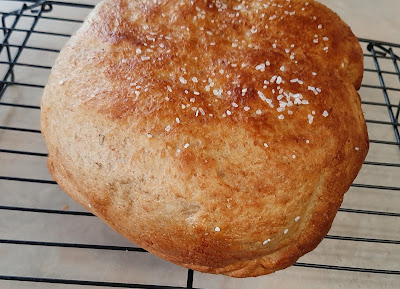Quite a few years ago a friend told me about making a loaf of bread in her crockpot. It was all the rage where she lived. I didn't really engage. It didn't seem particularly interesting, to say the least.
But over this time since the Pandemic and all the baking ventures that went with that, I have become more interested in making quick, tasty, healthy bread-- just a small loaf for my husband and I, made in one of our small appliances to save energy (and because my elderly oven is currently out of commission).
YOUTUBE IS THE PLACE TO GO FOR TUTORIALS ON BREAD-MAKING
After I had made some delicious bread in my small oven, I thought about my friend's description of making crockpot bread. I found that there are quite a few recipes and demos on YT. The one I chose to most closely emulate made the process look very easy, even using a blender (I think) to make the dough, and just feeding in 1/4 cup of flour (3 times) when the recipe didn't seem to work out as planned and 3/4 cups of flour were needed so that the author felt satisfied with the consistency of the dough.
She made it look very easy.
And I was looking for ease, as well as good wholesome ingredients.
The bread I made, following her original recipe, didn't require 3/4 of a cup more of flour. It all came together in a twinkling, and I didn't even have to form the boule on a floured counter, because it was practically formed right in the mixing bowl. I have never made such an easy bread... and delicious.
TOOLS AND INGREDIENTS I USED TO MAKE SOFT CROCKPOT BREAD
*A stand mixer with a large bowl, a whisk, and a dough hook
*A crock pot (or slow cooker?) with parchment paper covering the inside of the pot
*A toaster over with a broil setting to finish up the browning of the bread (a regular oven is okay too)
1 cup warm water
2 1/2 teaspoons dry active yeast (I use Instafirm dry active 'red' yeast)
1 teaspoon of sugar
1 cup whole wheat flour (I used Walmart brand organic whole wheat flour)
1 1/2 cups unbleached all-purpose flour (I used Annie's organic unbleached all-purpose flour)
2 tablespoons honey (optional-- for beegans)
3 tablespoons olive oil (other oils can be used-- your go-to/available oil is fine)
2 teaspoons salt
1 tablespoon herbs of choice I used an Italian mix I had handy.
**METHOD**
1. With the whisk attachment, and low speed, on your mixer, blend up the yeast, water, and the teaspoon of sugar. This will activate the yeast. Let it fizz up for 5 minutes. If there is no action, it us likely that your yeast is dead. Throw it out and start over with yeast that will rise.
2. Remove the whisk attachment, and put on the dough hook. Add the other ingredients (after the 5 minute 'rest' above) and mix on medium high. The dough should begin to form and the walls of the bowl will give up their dough to the hook. If this is not happening after a few minutes, add in a quarter of a cup of flour until the dough is clearing the bowl and is firm and elastic to the touch (OH!! Turn off the mixer before touching the dough).
3. If the dough becomes too dry (too much added flour), add in a tablespoon of water.
4. When the dough is made, peel it off the hook and lightly form a boule (ball)-- no more kneading needed).
5. Put the boule in your parchment-lined crockpot, turn it on to HIGH, put the lid on and come back to take a look from time to time, if you wish, but my bread was ready after about 1 1/2 hours (90 minutes).
6. Preheat your broiler for a few minutes and using your heat-safe gloves, remove the bread from the crockpot into your oven and broil for about 3 minutes to color the top of the bread. I found the base of mine was already golden brown and crispy. The golden coat is just cosmetic so don't overdo it trying to get the perfect tone. I did sprinkle on a little Kosher salt that sunk into the crust a little- just perfectly.
7. Cool the loaf on a rack. Slice and enjoy this very soft, tasty bread. The crust is thin and just right. Slices nicely and makes excellent toast. But remember... it is SOFT bread and not as firm as most bread. Serve it on a small plate (a bread and butter plate).
Nutritional Information per slice (assuming 10 slices):
Calories: Approximately 180 calories per serving
Protein: Approximately 4.5 grams per serving
Carbohydrates: Approximately 28 grams per serving
Fat: Approximately 6.5 grams per serving
Fiber: Approximately 2.5 grams per serving
Sugar: Approximately 2 grams per serving


Comments